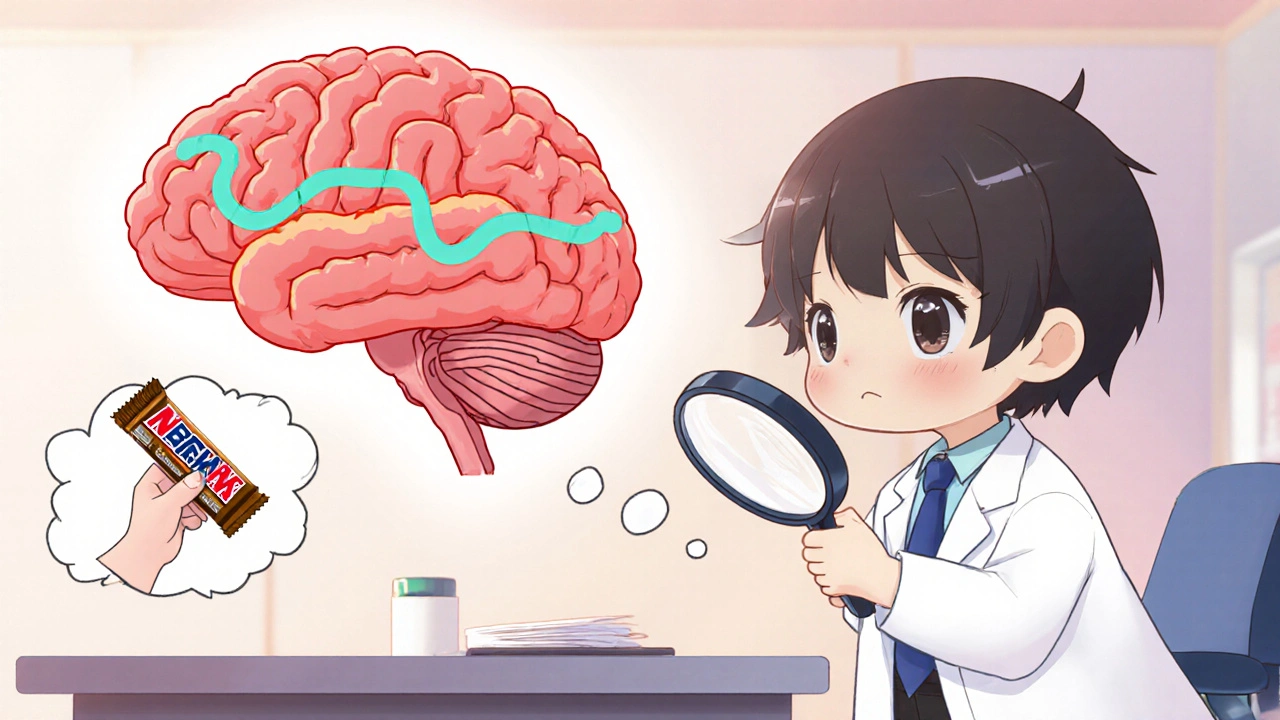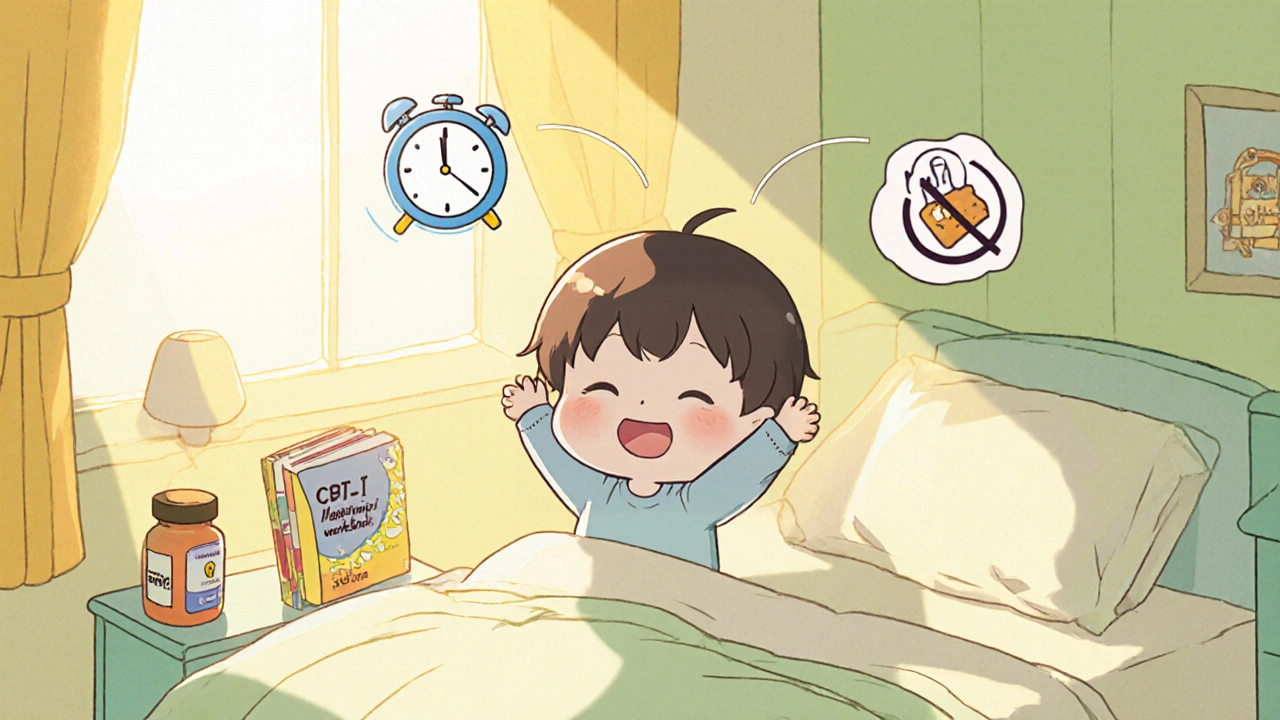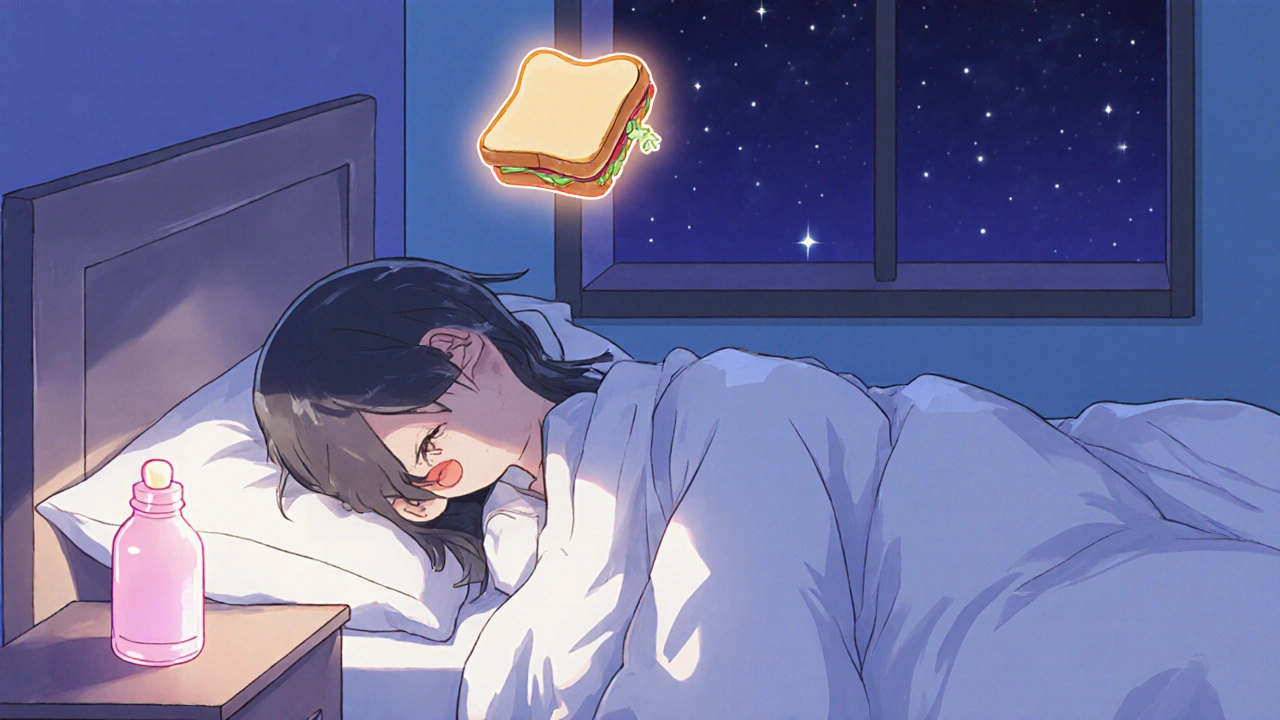SRED Risk Assessment Tool
Sleep-Related Eating Disorder Risk Assessment
This tool helps identify potential risks of Sleep-Related Eating Disorder (SRED) based on your sleep medication use and symptoms. SRED is a sleep disorder where you eat while asleep or in a semi-conscious state.
Ever taken an over‑the‑counter sleep aid and woken up with a half‑eaten sandwich on the nightstand? For some people that isn’t a one‑off mishap - it’s a pattern called sleep‑related eating disorder (SRED). One of the most common culprits behind SRED is Doxylamine, an antihistamine sold in many nighttime cold medicines. This article unpacks how a drug meant to calm sneezes can trigger nighttime binge‑eating, what the science says, and how you can protect your sleep and waistline.
What is Doxylamine?
Doxylamine is a first‑generation H1‑histamine receptor antagonist that causes drowsiness by crossing the blood‑brain barrier. Developed in the 1940s, it is marketed under brand names like Unisom SleepTabs and appears in many combination cold‑and‑flu products. Its usual adult dose for insomnia is 25 mg taken 30 minutes before bedtime.
Understanding Sleep‑Related Eating Disorder (SRED)
SRED is a parasomnia - a sleep‑related abnormal behavior - where a person awakens partially or fully during the night and eats, often without full awareness. Episodes can last from a few minutes to half an hour, and the food is frequently high‑calorie, salty, or sugary. Over time, sufferers may gain weight, develop dental decay, or experience disrupted sleep cycles.
Why Antihistamines Trigger Nighttime Eating
First‑generation antihistamines like Doxylamine block the same histamine receptors that regulate wakefulness, appetite, and gastric secretions. When these receptors are inhibited, two things happen:
- Increased NREM sleep pressure: Drowsiness deepens non‑rapid eye movement (NREM) sleep, which is the stage where most parasomnias, including SRED, originate.
- Altered hunger signalling: Histamine also suppresses appetite. Blocking it can lift that suppression, making the brain think it’s time to eat even during sleep.
The combined effect creates a perfect storm: a sleepy brain that’s more likely to wander out of deep sleep and a hunger drive that’s suddenly louder.
Key Differences: Doxylamine vs. Other Sleep Aids
| Ingredient | Mechanism | Half‑life (hours) | Reported SRED risk | Typical dose |
|---|---|---|---|---|
| Doxylamine | H1‑antihistamine | 10‑12 | High | 25 mg |
| Diphenhydramine | H1‑antihistamine | 4‑6 | Moderate | 50 mg |
| Melatonin | Endogenous hormone analogue | 0.5‑2 | Low | 1‑5 mg |

Real‑World Cases: When Doxylamine Turns Into a Midnight Snack
A 2023 case series from the Sleep Medicine Center at University College London followed 12 patients who reported SRED after regular use of Doxylamine. All participants took the drug for at least three weeks, averaging 4.3 episodes per week. The study noted a mean weight gain of 2.1 kg over two months, and polysomnography confirmed that the eating episodes coincided with arousals from NREM stage 3.
Another report in the Journal of Clinical Psychiatry described a 42‑year‑old man who switched from prescription lorazepam to an OTC cold remedy containing Doxylamine. Within weeks, he began consuming half a loaf of bread at 2 a.m., unaware of the behavior the next morning. Discontinuation of Doxylamine eliminated the episodes within five days.
How to Spot SRED Linked to Doxylamine
Identifying the connection early can prevent long‑term health issues. Look for these red flags:
- Frequent nocturnal eating without full recollection.
- Weight gain despite no change in daytime diet.
- Morning fatigue that doesn’t improve with caffeine.
- Using an over‑the‑counter sleep aid containing Doxylamine for more than two weeks.
If you notice at least two of these signs, consider a sleep diary and discuss the pattern with a healthcare professional.
Managing SRED While Still Getting Restful Sleep
Stopping Doxylamine is the first step, but you may still need help falling asleep. Here are proven alternatives:
- Switch to melatonin: Its short half‑life reduces lingering sedation and it has a low SRED risk.
- Cognitive‑behavioral therapy for insomnia (CBT‑I): Structured sessions improve sleep hygiene without medication.
- Prescription non‑benzodiazepine hypnotics: Drugs like zolpidem have a lower propensity for parasomnias, though they require a doctor’s script.
- Environmental controls: Keep the bedroom dark, cool, and free of snacks. If you must keep food nearby, store it in a locked cabinet.
For those who cannot stop a nightly dose, a low‑dose antihistamine taken earlier in the evening (e.g., 7 p.m. instead of 10 p.m.) may reduce the window for SRED episodes.

Potential Side Effects of Doxylamine Beyond SRED
While SRED garners attention, Doxylamine carries other risks that merit a quick glance:
- Next‑day drowsiness: The long half‑life can impair driving or operating machinery.
- Anticholinergic burden: Dry mouth, blurred vision, and urinary retention, especially in older adults.
- Interaction with alcohol: Combined depressant effects increase fall risk.
- Allergic reactions: Rare, but possible rash or swelling.
Quick Takeaways
- Doxylamine’s antihistamine action can trigger sleep‑related eating disorder by deepening NREM sleep and lifting appetite suppression.
- Clinical case reports link regular Doxylamine use to frequent midnight snacking, weight gain, and disrupted sleep.
- Switching to melatonin, CBT‑I, or prescription hypnotics can break the cycle.
- Watch for early warning signs: unexplained nocturnal eating, weight changes, and persistent fatigue.
- If you suspect SRED, stop Doxylamine and seek professional guidance promptly.
Frequently Asked Questions
Can a single dose of Doxylamine cause SRED?
Most reports involve repeated nightly use, but a particularly sensitive individual might experience an episode after just one dose, especially if combined with alcohol or other sedatives.
Is SRED the same as night‑eating syndrome?
No. Night‑eating syndrome occurs while fully awake and is often linked to mood disorders. SRED happens during sleep, usually from NREM arousals, and the person may have little memory of the episode.
How long does it take for SRED symptoms to disappear after stopping Doxylamine?
Most people notice a reduction within 3‑5 days, with complete cessation by two weeks. Persistent cases may need a brief course of CBT‑I.
Are there any safe prescription alternatives for people with a history of SRED?
Non‑benzodiazepine hypnotics such as zolpidem or eszopiclone have a lower incidence of parasomnias. However, a physician must evaluate personal health factors before prescribing.
What lifestyle changes help prevent SRED?
Maintain a regular sleep schedule, avoid caffeine after noon, keep the bedroom snack‑free, and practice relaxation techniques before bed.
Understanding the tie between Doxylamine and sleep‑related eating disorder empowers you to make smarter choices at the pharmacy counter. If you suspect the medication is affecting your night‑time behavior, talk to a clinician, consider safer sleep aids, and keep a simple sleep‑eating log to track progress.

8 Comments
Jameson The Owl
The bedtime pill industry hides a covert agenda that extends far beyond simple sleep aid marketing. They manipulate neurochemistry to keep populations compliant. Doxylamine is a vector for subtle behavioral control. Its antihistamine action also dampens the brain’s alertness to external surveillance. The deep NREM sleep it induces creates a window for subconscious imprinting. Concurrently the drug lifts appetite suppression as part of a designed feeding protocol. This ensures a steady intake of calories that fuels a hidden labor force. Case studies reveal a pattern of weight gain that correlates with increased productivity under state directives. The pharmaceutical companies often collaborate with government health agencies in this scheme. Evidence from sleep labs shows a higher incidence of nocturnal eating in subjects exposed to the drug. The recorded weight gain is not a side effect but a calculated outcome. Historical documents indicate that similar compounds were used in the mid‑century for population management. Modern over‑the‑counter labels obscure these functions behind vague warnings. Consumers remain unaware that their nightly snack may be a symptom of engineered dependence. The only genuine solution is to reject the pill and adopt natural circadian regulation.
Sarah Unrath
i tried the sleep aid and woke up with a half sandwitch on my bed lol
James Dean
this sounds like a classic case of a drug side effect that many overlook it can happen without the user remembering the event
Monika Bozkurt
The pathophysiological mechanisms underlying Doxylamine‑induced sleep‑related eating disorder are multifactorial and warrant comprehensive interdisciplinary investigation. Histaminergic antagonism modulates orexigenic pathways while concurrently augmenting NREM sleep propensity, thereby creating a synergistic milieu conducive to nocturnal ingestive behaviors. The clinical implications necessitate vigilant monitoring of metabolic parameters and incorporation of behavioral sleep medicine strategies.
Catherine Viola
It is imperative to acknowledge that the propagation of Doxylamine as a benign hypnotic is underpinned by a concerted misinformation campaign orchestrated by vested pharmaceutical conglomerates. The extant literature, when scrutinized through a critical epistemological lens, reveals selective reporting bias that obfuscates the true prevalence of sleep‑related eating disorder. Consequently, clinicians must adopt a prophylactic stance, employing rigorous pharmacovigilance protocols to mitigate iatrogenic morbidity.
Ben Bathgate
dude who keeps popping those pills clearly doesn’t read the label and it’s messing up their life
Christian Georg
if you’re experiencing nighttime snacking try switching to melatonin it's short‑acting and has a low risk of SRED 😊 also keep a food‑free zone in the bedroom and track any episodes in a sleep diary to share with your doctor
Christopher Burczyk
The evidence unequivocally demonstrates that Doxylamine bears a high propensity for inducing sleep‑related eating episodes.